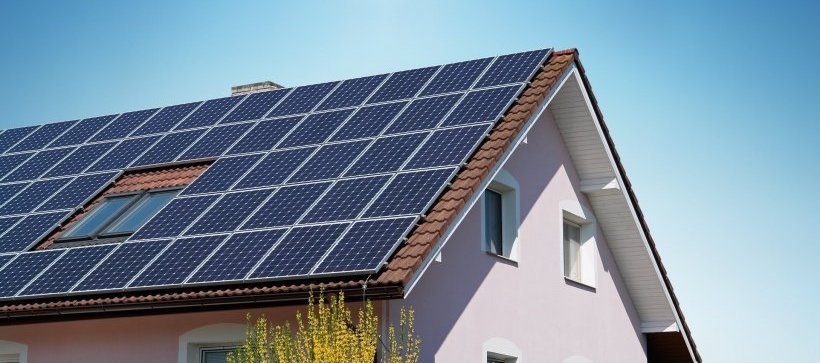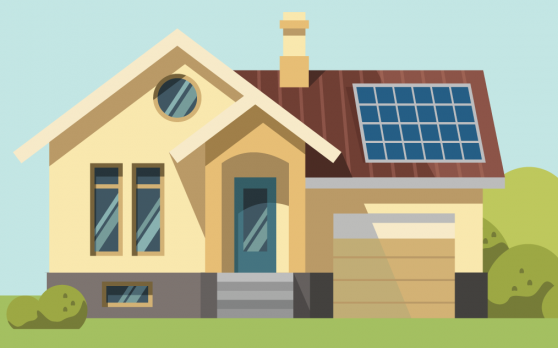Some people like to say that solar power is free, but that’s not exactly true. Solar power fuel (sunlight) is free, but to take advantage of that fuel you need the proper solar equipment (and that can get pretty expensive!).
Based on a solar panel system size of 6.5 kW and a price of $3.10 per watt, the average cost of solar panels is $20,150. There is a wide variation in real-world prices, however, due to differences in incentives, financing, and other factors.
Suffice it to say the cost of a solar installation can get complicated pretty quickly. We’re going to make things as simple as possible by answering the following questions:
- What factors affect the cost of a solar installation?
- How can solar incentives reduce your costs?
- What is the best way to finance your solar panels?
- How much money will you save with a solar energy system?
When you have answers to these questions, you will have a better idea of what solar energy costs you should expect. Let’s start with what can affect the price of a solar power system.
What Factors Affect The Cost of a Solar Installation?
When people ask how much solar panels cost, they usually receive a very familiar answer: ‘It depends’. Unfortunately there is no way to avoid this frustrating answer as there are many factors that affect the cost of solar panels.
Let’s take a look at some of these factors so you’ll know how much you should expect to pay for your solar installation. The following factors can significantly affect your solar price:
- Size of Solar Power System
- Type of Solar Panels
- Solar Batteries Included?
Size of Solar Power System
The size of the solar power system you choose will have a big impact on your costs. Solar power systems are sized in ‘kilowatts’ (a kilowatt is a thousand watts). The total system size is determined by adding up the wattage rating of the solar panels. For instance, if you install 10 solar panels that are rated at 400 watts each, your total system size is 10 x 400 = 4000 watts or 4 kilowatts (kW).
Based on a price of $3.10 per watt, a 4kW system would cost $12,400 whereas a 10kW system would cost $31,000. That’s a pretty big difference! So how do you decide what size of solar energy system to install?
The first thing to consider is the roof space you have available. This may limit the potential size of your solar installation before any other considerations are made. You should also consider your budget and know how much you’re able to spend. Thirdly, use your electric bills to calculate your electricity usage in kilowatt hours (kWh). You can then decide if you want to eliminate your bill or just reduce it.
All of these considerations will affect your choice of what size of solar system to install.

Type of Solar Panels
In addition to deciding on the size of your solar power system, you will also have the following solar panel options:
- Monocrystalline
- Usually offer the highest solar panel efficiency. These panels are also a little more expensive.
- Polycrystalline
- Less efficient than monocrystalline panels. These panels are also cheaper than the monocrystalline variety, however, and may be your best ‘dollar per watt’ option.
- Thin-Film
- Not as popular as the crystalline panel options and they only make up about 10% of the solar PV market. These panels are higher cost and don’t offer significant advantages in most residential and commercial applications.
Working with a solar installer should help you determine which of these solar panel types will work best in your situation. A solar professional will also be able to provide you with a comparison of how each panel type will affect your system cost.
Solar Batteries Included?
Most residential solar installations do not have batteries. These systems effectively use the power grid as a battery. When the sun isn’t shining and the panels aren’t producing any power, the home draws power from the grid.
In order to find out if this is possible in your situation, check out your utility company’s ‘net metering’ policy. Net metering is a billing mechanism that credits solar panel owners for the electricity they add to the grid. You can use these credits for ‘free power’ when your system is producing less power than you’re consuming.
One downside to not having batteries is that you will not have any backup power if there is a power outage. The upside to not having batteries is that you will save a lot of money! Although the cost of solar batteries has come down in recent years, they still represent a significant part of a system’s cost. For instance, a single Tesla Powerwall battery has an installed cost of $11,500.
You will have to decide if the peace of mind of having back-up power is worth the additional cost.
How can solar incentives reduce your costs?
So far we have looked at the cost of solar panels before any solar incentives are taken into account. The good news is that incentives can significantly reduce the price of your system.
Incentives will differ depending on where you live, but these are the categories you should look for:
- Solar Tax Credit
- Solar Power Rebate
- Tax Exemption
- Performance Based Incentive (PBI)
Solar Tax Credit
A solar tax credit can have a big impact on the cost of your solar panel installation. If you’re in the US, you should be able to take advantage of the Investment Tax Credit (also known as the Federal Solar Tax Credit). This is a 30% tax credit that can reduce the cost of your solar panel installation by thousands of dollars.
If you spent $20,150 on a new solar panel array and took advantage of the 30% tax credit, you would reduce your taxes owed by over $6,000! Also, there is no cap on the amount that can be claimed and the credit applies to the full amount you paid for your solar panel installation. This includes:
- Solar Panels
- Installation Costs
- Balance of System Equipment (wiring, inverter, mounting)
- Energy Storage Devices
- Sales Tax on Eligible Expenses
State rebates and tax credits generally do not reduce the amount of the federal tax credit you receive. This means you may not have to subtract any state or local incentives you receive before you calculate the 30% tax credit (Note: this should not be considered tax advice).
The following are the main eligibility requirements for the federal solar tax credit:
- The solar power system is new (not used)
- The solar panels are installed at your primary or secondary residence
- You own the solar power system
Solar Power Rebate
A solar energy rebate usually refers to a one-time payout you receive from a utility or government when you install solar panels. For United States residents the best way to find out which solar rebates are available to you is to check out something called the Database of State Incentives For Renewables & Efficiency (DSIRE).
DSIRE was established in 1995 and it is funded by the U.S. Department of Energy. When you go to the DSIRE website just enter your zip code or click on your state to check out all the programs available to you.
Tax Exemption
The following are the two kinds of tax exemptions that may be available when you install solar panels:
- Sales Tax Exemption
- This reduces the upfront cost of the system by exempting solar energy devices and installation from sales tax.
- Property Tax Exemption
- Solar panels can increase the value of your home. This is a good thing, but it can also mean a higher property tax bill. Fortunately many states have property tax exemptions for solar energy so you won’t face a property tax increase.
Performance Based Incentive (PBI)
Unlike the federal solar tax credit that is based on the cost of your system, a performance based incentive (PBI) is based on how much electricity your system actually produces.
Examples of PBIs include:
- Feed-In Tariff (FIT)
- A FIT requires a utility company to purchase the electricity your solar panels produce. This usually takes the form of a long-term contract that guarantees a certain rate for each kilowatt hour of electricity produced.
- Solar Renewable Energy Certificates (SRECs)
- If you live in an eligible market, you can earn 1 Solar Renewable Energy Credit (SREC) for every megawatt hour your solar system produces. For reference, a 5kW system should produce around 6 SRECs per year. You can then sell your SRECs to a utility company that needs to meet its renewable energy quota. The market for a SREC varies from a few bucks to several hundred dollars. You can check out the SREC market here.

What is the best way to finance your solar panels?
Now that you’ve reduced the cost of your solar panels by taking advantage of solar incentives, you have to decide how you’ll pay the remaining amount. This is when your solar financing options come into play.
If you don’t have the money to pay for your solar panels up front, your solar financing options are:
- Solar Loan
- Solar Lease
- Power Purchase Agreement
Solar Loan
The biggest advantage of paying for your system with a solar loan is that you will own the system. This differs from a solar lease or power purchase agreement where your system is owned by a third party.
Owning the system is important because it means you are eligible for the Federal Solar Tax Credit or any other solar incentives. Also, you will benefit from the increase in home value that solar panels typically provide. For these reasons, a solar loan is preferable to the other forms of financing as it can reduce the overall cost of solar panels.
Solar loan options include:
- Personal Loan
- Home Equity Loan
- Home Equity Line of Credit
- Fannie Mae HomeStyle Energy Program
- Solar Installer Loan
- Property-Assessed Clean Energy (PACE) Loan
Solar Lease
A solar lease makes it possible for you to get solar panels with no money down and may allow you to start saving money on your electric bill as soon as your panels are installed. As a bonus, the solar leasing company is usually responsible for monitoring power output and performing any necessary repairs.
As we mentioned earlier, however, there is a downside to a solar lease: You are not the owner of your solar power installation! This means you won’t be eligible for the Federal Solar Tax Credit and other incentives. This can seriously affect your return on investment.
Power Purchase Agreement
A power purchase agreement (PPA) is similar to a solar lease in that a third party owns and maintains the solar panels on your roof. Instead of making a set monthly lease payment, however, you purchase the power produced by the panels at a preset rate.
The downside to a PPA will sound familiar: You will not be the owner of your solar panels so you will not be eligible for tax credit or rebates.
How much money will you save with a solar energy system?
I think it’s time for a recap on what we’ve learned about the cost of solar power:
- An average solar power system costs $20,150
- Various solar incentives could dramatically reduce this amount
- How we finance the remaining amount also affects our return on investment
Now it’s time to consider whether the cost of solar panels is really that important. We don’t want to downplay the importance of financial considerations, of course, but maybe there’s another way to think about this. Instead of asking ‘how much do solar panels cost?’ let’s ask ‘how much money will solar panels save me?’. To answer this question we will consider two factors:
- Solar Savings
- Solar Payback Period
Solar Savings
Although it may seem counterintuitive, high electricity costs are a good thing when it comes to saving money with solar panels. This is because your savings really add up when your solar power replaces more expensive electricity from your utility company.
To learn more about your potential savings, it’s a good idea to review your electric bills and find out how much you’re actually spending. As an example, the average cost of electricity in the US is 15.42 cents per kilowatt hour and the average electricity consumption per household is 11,000 kilowatt hours per year.
If we multiply 15.42 by 11,000 we see that the average household pays around $1700 per year for electricity. This means that if we buy a solar power system that eliminates our electric bill we will be saving about $1700 per year.
Now we can figure out how long it will take for our solar investment to pay for itself.
Solar Payback Period
Your solar payback period refers to the amount of time it will take the savings on your electric bill to equal what you paid for your solar panel system. It tells you when your ‘break even point’ will occur.
Let’s use average solar and electrical costs as an example:
Solar Power System Cost: $20,150
Subtract 30% Tax Credit: $6,045
Net Solar System Cost: $14,105
Annual Electricity Cost: $1,700
Net Solar System Cost ($14,105) / Annual Electricity Cost ($1,700)
= Payback Period (8.29 years)
This means that it will take 8.29 years for your electricity savings to equal the cost of your solar power system. If the utility company raises the price of electricity the payback will occur even more quickly.
The real good news about this payback period is that the solar panels will be ‘paid off’ by electricity savings in around 8 years and they will be producing electricity for at least 25 years. This means you will enjoy many years of free electricity long after your initial investment has been returned through savings.
Wrap-Up
As we mentioned earlier, the cost of solar panels can get complex due to the many factors involved. Now that you’re aware of these factors you’ll know what to look for when considering a solar installation.
When you’re ready to take the next step, we recommend getting several solar power quotes from qualified installers in your area. With what you learned today, you’re ready to chat with an installer about solar prices, incentives, financing, and payback period. Good luck!
